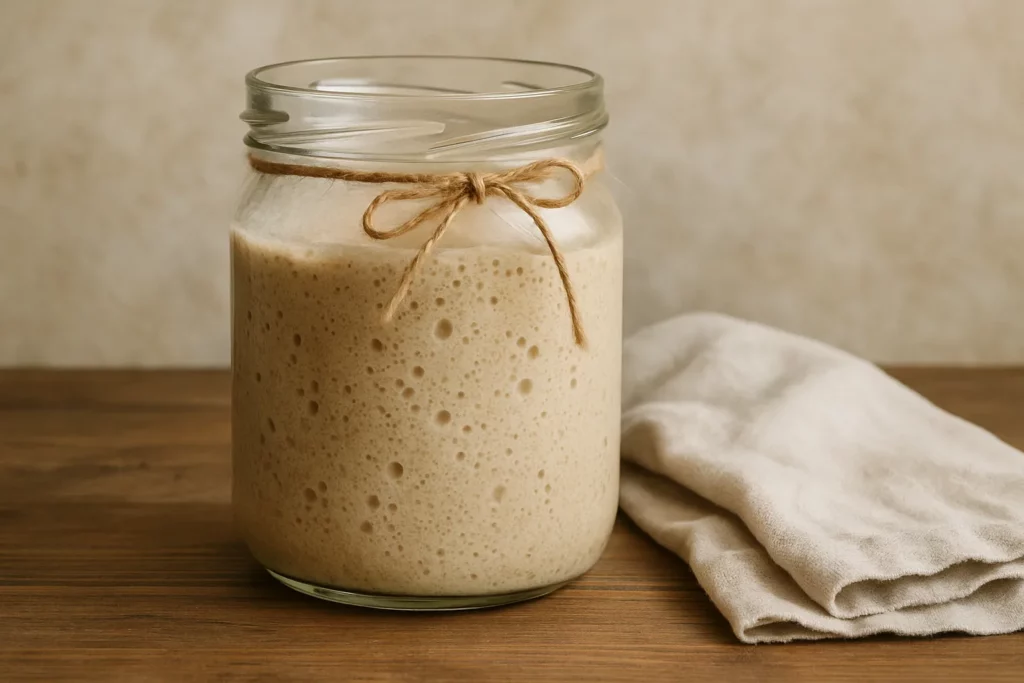- General
- Our Bakery
- Trends
Is Sourdough good for you?

The Sourdough Secret: Why This Healthy Bread is Better For You
Forget the fads. We’re diving into the science behind why traditional sourdough is a genuinely healthier choice.
The Search for a Truly Healthy Bread
What Makes Sourdough a Healthy Bread? The Fermentation Factor
The magic of sourdough lies in its starter, a living ecosystem of wild yeasts and Lactic Acid Bacteria (LAB). Unlike commercial yeast, which is a single strain bred for speed, a sourdough starter is a diverse community that works slowly over 18-36 hours. This extended time is crucial. The microbes aren’t just making the bread rise; they’re fundamentally changing the flour’s chemistry for the better.
- Wild Yeasts & Bacteria: This symbiotic culture produces CO2 for leavening and organic acids (like lactic acid) that create the signature tang and lower the dough’s pH.
- Slow Transformation: This long process breaks down proteins (like gluten) and neutralises compounds that can hinder nutrient absorption, making sourdough a more wholesome and healthy bread.
Easier Digestion: A Key Sourdough Benefit
One of the most celebrated benefits of sourdough is that it’s kinder on your gut. The long fermentation process acts as a form of “pre-digestion,” breaking down components of the flour that can cause issues for some people.
Partial Gluten Breakdown
The acidic environment and enzymes in the starter begin to break down gluten proteins. This doesn’t make the bread gluten-free (it’s still unsafe for coeliacs), but it can significantly reduce the gluten load. Many people with non-coeliac gluten sensitivity find they can enjoy true sourdough without the bloating and discomfort they get from regular bread.
Unlocking Nutrients by Reducing Phytic Acid
Whole grains contain phytic acid, an “anti-nutrient” that can block your body from absorbing minerals like iron, zinc, and magnesium. The long, slow fermentation of sourdough activates an enzyme that breaks down up to 90% of this phytic acid. This means your body can actually access and use more of the inherent goodness in the grain, making every slice more nutritious.
Sourdough, Blood Sugar, and the “Low Calorie Bread” Myth
While sourdough isn’t necessarily a low calorie bread—its calories are similar to other breads made from the same flour—its effect on your body is vastly different. This makes it a much smarter choice for metabolic health and weight management.
Sourdough has a lower Glycemic Index (GI) of around 54, compared to regular bread’s GI of 71. This means it releases sugar into your bloodstream much more slowly, preventing the sharp spikes and crashes in energy and insulin that can lead to cravings and fat storage. This is due to the organic acids and ‘resistant starch’ created during fermentation, which slow down digestion. So, while not a “diet” food, its ability to keep you feeling fuller for longer and stabilise your blood sugar makes it a powerful ally in a healthy diet, far superior to a typical processed low calorie bread that offers little nutritional value.
How to Choose the Best Sourdough Bread (and Avoid the Fakes)
The term “sourdough” isn’t regulated, leading to many “sourfaux” products on the market. These are just standard loaves with added sour flavourings, offering none of the health benefits. Finding the best sourdough bread is simple if you know what to look for.
Check the ingredients list. Authentic sourdough should only contain: flour, water, and salt. The starter might be listed as “sourdough starter,” “culture,” or “leaven.” If you see “yeast,” vinegar, preservatives, or dough conditioners on the label, it’s not the real deal. For the most healthy bread, choose a loaf made with whole-grain flours to get the combined benefits of fermentation and fibre.
| Feature | Authentic Sourdough | Regular Commercial Bread |
|---|---|---|
| Glycemic Index (GI) | Low (~54) | High (~71) |
| Nutrient Absorption | Higher (minerals are more bioavailable) | Lower (due to phytic acid) |
| Digestibility | Easier (gluten and FODMAPs are reduced) | Can cause bloating for sensitive individuals |
| Ingredients | Flour, water, salt | Often includes yeast, preservatives, sugar, emulsifiers |
Conclusion: An Informed Choice for a Healthier Loaf
The evidence is clear: authentic, long-fermented sourdough is a demonstrably superior and healthy bread. Its benefits—better digestion, enhanced nutrient absorption, and improved blood sugar control—are a direct result of its traditional preparation. By choosing loaves made with simple, quality ingredients, you can confidently enjoy bread that is not only delicious but also a genuinely healthier part of your diet.
Ready to Try the Best Sourdough Bread?
Experience the difference that traditional methods and quality ingredients make. Our authentic sourdoughs are crafted for superior taste and nutrition.



